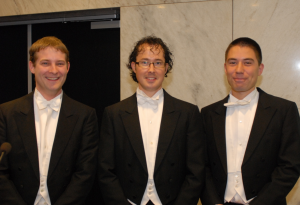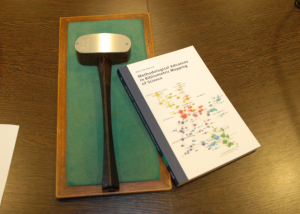PhD Thesis Defense Nees Jan van Eck on Methodological Advances in Bibliometric Mapping of Science
On October 13, Nees Jan van Eck defended his thesis entitled "Methodological Advances in Bibliometric Mapping of Science". His promoter and co-promoter are Prof.dr.ir. R. Dekker and Dr.ir. J. van den Berg, respectively. Other members of the Doctoral Committee are Prof.dr. P.J.F. Groenen, Prof.dr.ir. U. Kaymak, and Prof.dr. A.F.J. van Raan.
In his dissertation, Nees Jan van Eck focuses on maps beyond showing geographical information by providing techniques to visualize all kinds of intellectual landscapes. He attempts to visualize the landscape of science by mapping bibliographic data and introduces techniques providing fascinating insights into scientific structures, such as the organization of science into disciplines, fields, and subfields or the organization of scientific literature into a number of interconnected themes. Van Eck says: "The techniques also make it possible to reveal how science is evolving over time".
Van Eck explains that all visualizations are produced in a fully automated way, which ensures that they provide objective representations of the structure of science. Examples of maps of intellectual landscapes include a map that presents the overall structure of science, indicating a more or less circular structure in which the medical sciences are connected to the life sciences, the life sciences to the natural sciences, and the natural sciences to the engineering sciences as well as to mathematics and computer science. Computer science in turn has connections to the social sciences, in particular to economics and management. The social sciences are connected to psychology, and the circle is closed by the connection between psychology on the one hand and the medical and health sciences on the other hand. By showing this, van Eck’s research is helpful to get a better understanding of the structure of scientific fields, for instance of the different topics studied in a field and of the relations between these topics. This has a significant practical relevance in the area of science policy and research management. Thus, using the techniques introduced in his thesis, policy makers may be able to make better informed decisions, which may for instance result in an improved allocation of research funding.
About Nees Jan van Eck Nees Jan van Eck (1982) obtained his master's degree in Informatics & Economics with honors from Erasmus University Rotterdam in 2005. In the same year, he started his PhD research at the Econometric Institute of the Erasmus School of Economics. Nees Jan’s PhD research is in the field of bibliometrics and scientometrics and focuses on bibliometric mapping of science. Results of his research have been presented at various international conferences and have been published both in bibliometrics/scientometrics journals (Journal of Informetrics, Journal of the American Society for Information Science and Technology, and Scientometrics) and in computer science journals (IEEE Computational Intelligence Magazine and International Journal of Uncertainty, Fuzziness and Knowledge-Based Systems). As part of his PhD research, Nees Jan has developed a computer program for bibliometric mapping called VOSviewer (www.vosviewer.com).
Nees Jan van Eck (1982) obtained his master's degree in Informatics & Economics with honors from Erasmus University Rotterdam in 2005. In the same year, he started his PhD research at the Econometric Institute of the Erasmus School of Economics. Nees Jan’s PhD research is in the field of bibliometrics and scientometrics and focuses on bibliometric mapping of science. Results of his research have been presented at various international conferences and have been published both in bibliometrics/scientometrics journals (Journal of Informetrics, Journal of the American Society for Information Science and Technology, and Scientometrics) and in computer science journals (IEEE Computational Intelligence Magazine and International Journal of Uncertainty, Fuzziness and Knowledge-Based Systems). As part of his PhD research, Nees Jan has developed a computer program for bibliometric mapping called VOSviewer (www.vosviewer.com).
Since 2009, Nees Jan has been working as a researcher at the Centre for Science and Technology Studies of Leiden University. He has continued his work on bibliometric mapping of science and on the development of the VOSviewer software, but he has also broadened his interests to other topics in the field of bibliometrics and scientometrics. In 2010, a short research note on one of his bibliometric mapping projects was published in Nature.
Abstract
Bibliometric mapping of science is concerned with quantitative methods for visually representing scientific literature based on bibliographic data. Since the first pioneering efforts in the 1970s, a large number of methods and techniques for bibliometric mapping have been proposed and tested. Although this has not resulted in a single generally accepted methodological standard, it did result in a limited set of commonly used methods and techniques.
In this thesis, a new methodology for bibliometric mapping is presented. It is argued that some well-known methods and techniques for bibliometric mapping have serious shortcomings. For instance, the mathematical justification of a number of commonly used normalization methods is criticized, and popular multidimensional-scaling-based approaches for constructing bibliometric maps are shown to suffer from artifacts, especially when working with larger data sets.
 The methodology introduced in this thesis aims to provide improved methods and techniques for bibliometric mapping. The thesis contains an extensive mathematical analysis of normalization methods, indicating that the so-called association strength measure has the most satisfactory mathematical properties. The thesis also introduces the VOS technique for constructing bibliometric maps, where VOS stands for visualization of similarities. Compared with well-known multidimensional-scaling-based approaches, the VOS technique is shown to produce more satisfactory maps. In addition to the VOS mapping technique, the thesis also presents the VOS clustering technique. Together, these two techniques provide a unified framework for mapping and clustering. Finally, the VOSviewer software for constructing, displaying, and exploring bibliometric maps is introduced.
The methodology introduced in this thesis aims to provide improved methods and techniques for bibliometric mapping. The thesis contains an extensive mathematical analysis of normalization methods, indicating that the so-called association strength measure has the most satisfactory mathematical properties. The thesis also introduces the VOS technique for constructing bibliometric maps, where VOS stands for visualization of similarities. Compared with well-known multidimensional-scaling-based approaches, the VOS technique is shown to produce more satisfactory maps. In addition to the VOS mapping technique, the thesis also presents the VOS clustering technique. Together, these two techniques provide a unified framework for mapping and clustering. Finally, the VOSviewer software for constructing, displaying, and exploring bibliometric maps is introduced.
More information
Pictures of the defense
Fulll text of the dissertation

